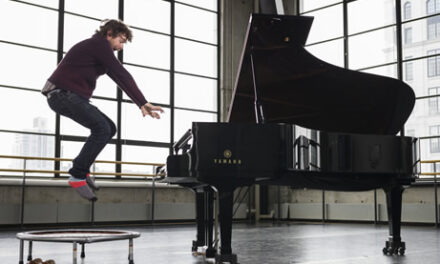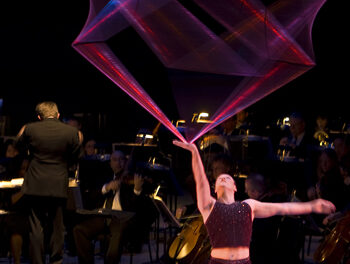The student orchestra of the University of North Carolina School of the Arts filled the stage of the Stevens Center for a concert in honor of the 200th anniversary of the birth of Richard Wagner, in a program which situated him amongst his contemporaries. Faculty conductor James Allbritten narrated the program, which included a work by Wagner’s father-in-law (Franz Liszt), the fiendishly difficult Totentanz (Dance of Death), a work pivotal in Wagner’s decision to become a composer rather than a playwright (Beethoven’s Egmont), as well a popular excerpt from the Ring cycle, the warhorse, “The Ride of the Valkyries.”
As in the season-opening September concert, (which wasn’t announced in time to meet CVNC‘s timeline), Maestro Allbritten has produced a thematic tour de force, invoking the context surrounding the creation of earth-changing works of the highest artistic value. Whereas in the September concert we were introduced to the Battle of the Romantics, the old guard represented by mature Brahms (Symphony No. 4 in E minor) and the new by early Wagner (Overture to Der fliegende Holländer [Flying Dutchman]), and a middle ground represented by young Richard Strauss (the Horn Concerto No 1, terrifically played by UNCSA student Jessica Appolinario), the October concert, “Wagner and His World” carried us to the apex of this “new” style of composition in the Prelude to Tristan und Isolde.
The concert opened with the too-infrequently-heard Overture to Der Freischütz, an opera (1820) by Carl-Maria von Weber, acknowledged to be the first composer of German opera. (Although Mozart had written Zauberflöte and Entführung aus dem Serail in German, most of his operas were written in Italian.) Except for a wayward “E” (sharp in the horns), the lovely horn quartet, complemented by a warm string sound and dramatic harmonies in the clarinets, started this work off well. The brooding syncopations of the main C minor theme led to a finely burnished climax in which the brass distinguished themselves.
As the stage was reset with the Steinway center-stage, Allbritten introduced us to “rock star” Franz Liszt, who after a quarter century as the darling of concert stages all around Europe decided to devote himself to composition, including the evening’s solo piece, the Gothic masterpiece, Totentanz (Dance of Death, final version, 1859) which is a series of variations on the medieval hymn for the dead, Dies irae, already made popular by Liszt’s friend, Hector Berlioz, the iconoclast French composer and innovator, in his Symphonie fantastique (1830).
The soloist for the Liszt was Dmitri Shteinberg, a recent addition to the faculty of UNCSA – and what an acquisition! Entering and seating himself without any fuss, he started to play, filling the hall with sound and the audience with awe. Placing his impeccable technique at the service of Liszt’s diabolic demands, Shteinberg gave each of the six sections of the piece personalities of their own, sometimes cascades of sound mingling with glissandi and at other times tight canons, yielding to dreamy arpeggio passages and repeated note passages and then modulating into a grandiose cadenza. The orchestra and Maestro Allbritten kept pace, making this one of the highlights of UNCSA orchestral concerts of recent years.
After intermission the student orchestra was directed by one of its own, conducting student, John McKeever, who led the benevolent orchestra in an uneventful rendering of Beethoven’s Overture to Egmont. One might have wished for a more authoritative, assertive performance of Beethoven’s overture to Goethe’s play about of the beheading of Lamoral, the Count of Egmont, fomenting the rebellion of the Dutch against the Spaniards. The presence of a very large bass section (10 basses vs. 9 cellos and 5 violas) was of great help, because of Beethoven’s innovative separation of basses from the cellos, used to playing in octaves during the earlier Classical period.
Maestro Allbritten, after a humorous caricature of the Valkyries, led a stunning performance of the “Ride of the Valkyries” from Act III of Die Walküre, the second opera of the Ring Cycle, in which the brass were splendid, showcasing the difference between the horn/tuba family and the trumpet/trombone family. As Allbritten quipped, “It takes a lot of horns [10 on this occasion] to get a Valkyrie up to Valhalla!”
This entire concert, for all its spectacular side trips, was building up to the closing work, and the work of Wagner which changed the face of music – the Prelude to Tristan and Isolde, completed by the closing scene of the opera, “Isolde’s Death,” with UNCSA alumna Carter Scott, soprano, singing the role of Isolde. This vocal part, essential to the complete staged opera is often omitted in unstaged versions because it is doubled in the orchestra. But the presence of Ms. Carter to sing the role of Senta in the Piedmont Opera’s upcoming performances of Der fliegende Holländer made it possible to let us hear her terrific voice, rich and dark, yet powerful enough to sail across the orchestral largesse of Wagner.
This was an excellent concert of mostly familiar works, presented with a theme that unified the diversity of the pieces. The next UNCSA concert, November 8, will pay homage to another bi-centenarian, Giuseppe Verdi with his monumental Requiem. For details, click here.












